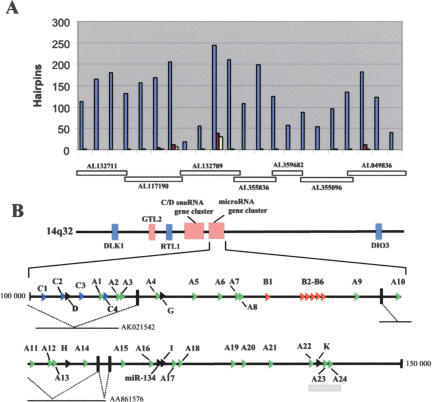Figure 2.
Identification of computationally predicted miRNA genes at the human imprinted 14q32 domain. (A) Distribution of the conserved hairpins between human and mouse along the 1-Mb-long imprinted 14q32 domain. Vertical bars indicate the number of in silico-predicted hairpins found within each 50-kb-long region. Blue bars indicate the number of human hairpins at the 14q32 domain; red bars, the number of conserved hairpins between mouse and human; and yellow bars, the number of conserved hairpins giving rise to a miRscan score >10 (Lim et al. 2003). The relative positions of the overlapping human BACs covering the analyzed domain are indicated below the histogram. (B) A large cluster of miRNA genes mapping downstream from the C/D snoRNA gene cluster. miRNA genes belonging to the A-, B-, and C-types are represented by green, red, and blue arrows, respectively, and miRNAs encoded by a single-copy gene (miR-D, G, H, I, K) are indicated as black arrows. Note that four miRNA genes—miR-A22, miR-K, miR-A23, and miRA24—are embedded within a conserved CpG island (indicated by a gray rectangle) from which the most conserved sequences lie within the pre-miRNA genes (data not shown). Dotted lines denote splicing events identified by ESTs analysis. Numbering indicates the relative position of the miRNA gene cluster (in nucleotides) within the BAC AL132709 sequence. The picture is drawn to scale.

